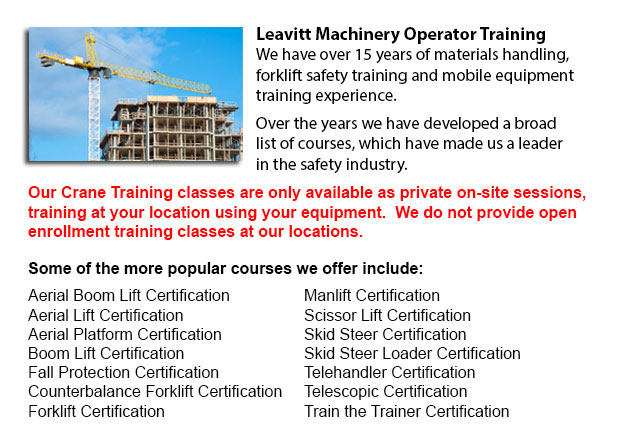
Overhead Crane Safety Training Grande Prairie - Overhead crane safety training equips operators with knowledge and skills regarding crane safety precautions, accident avoidance, materials handling, and equipment and stock protection. Trainees will learn the kinds of overhead cranes, their capabilities and their uses in different industry settings. For operators who are licensed and trained, the shift in liability moves to the operator from the company. Therefore, the program emphasizes individual operator duties.
Overhead crane safety training instructs operators in the correct techniques for doing inspections. Two kinds of pre-shift check are the walk-around inspection and the in-depth inspection. These are important every day routines which must be logged. Properly recorded pre-shift inspections help to protect the business from liability in case of an accident. Pre-shift checks also prevent accidents, damage and costly repairs. Operators learn how to designate a specific individual to perform inspections, how to maintain the log book and how to report problems.
Checks must be performed often and documented right. The following must checked while watching for common problems: increase in the throat opening, hooks for cracks, degree of twist; hoist ropes for corrosion, loss of diameter, worn wires, broken wires, bird caging and kinks, heat and chemical damage; chains for gouges and nicks, twists, cracks and corrosion, excessive wear, distortion, stretching, pits, damage caused by extreme heat.
Operators learn correct rigging methods in this course. Rigging includes understanding the manufacturer's data plate, determining the weight of materials to be lifted, selecting the gear, and using safe practices to secure the load. The course include in detail the following: safe working loads, and the capacities of ropes, chains, slings, hooks and shackles.
It is essential to know who could utilize the cranes at your facility, physical requirements of the job, and operator credentials required for permits and specialized tasks. Safety must be prioritized when using in the vicinity of pedestrian traffic.
Safe crane operation involves duties like for instance undertaking visual inspections, checking for hydraulic leaks, checking the safety guards, testing the controls, examining the hook and hoist rope, limit switches and braking mechanisms. Correct reporting procedures are critical. These subject matters are all included in depth in the course.
Proper lifting and moving procedures with cranes and hoists are covered in the course. Operators would become knowledgeable in hand signals. Training includes how to attach the load, raise the load, abort a lift, set the load and unhook the slings.
The steps included with moving the load, includes: stopping and starting procedures, controlling and guiding the load, observing working conditions and working with signals. In the event of power failures, the operator will have to know how to proceed. The course covers methods for lowering the load and removing the slings, storage of equipment, parking the crane, and securing an indoor and outdoor crane.
-
Forklift Operator Certification Grande Prairie
Forklift Operator Certification Grande Prairie - Certification for forklifts are needed to ensure the safe utilization of forklifts for those employers in industrial, warehouse or construction environments. The training has to involve a method of edu... More -
Skid Steer Ticket Grande Prairie
Skid Steer Ticket Grande Prairie - On a skid-steer loader, the lift arms are beside the driver along with pivot points behind the driver's shoulders. This makes them different as opposed to a conventional front loader. Due to the operator's proximity... More -
Order Picker License Grande Prairie
Order Picker License Grande Prairie - Order preparation operation or order picking as it is more usually known is a method utilized in warehouse operations and consists of staff referred to as order pickers. The order picker's job is to take and coll... More -
Telehandler Certification Grande Prairie
Telehandler Certification Grande Prairie - Telehandler certification programs are both for operators who have some experience driving a typical forklift and for people with no experience. The real-world training provided by these programs produces gr... More -
Skid Steer Loader Training in Grande Prairie
The engine powered skid-steer loader consists of a small and rigid frame, equipped with lift arms which could attach to numerous industrial attachments and tools in order to perform various labor saving tasks. Typically, skid-steer loaders are four-w... More -
Crane Training School Grande Prairie
Crane Training School Grande Prairie - The crane training school offers industry-relevant programs. Courses provide trainees with learning results that match current industry demands. Our small class sizes combine theory and hand-on experience. Our q... More -
Telehandler License Grande Prairie
Telehandler License Grande Prairie - The telescopic handler or telehandler is a commonly used machine in agricultural and industrial applications. This equipment is similar in look to a forklift and even works in a similar manner, even though telehan... More -
Aerial Boom Lift Ticket Grande Prairie
Aerial Boom Lift Ticket Grande Prairie - Aerial lifts can be utilized to accomplish several unique tasks executed in hard to reach aerial spaces. A few of the odd jobs associated with this kind of lift include performing daily maintenance on structur... More

Forklift Training Grande Prairie
TOLL FREE: 1-888-254-6157
11205-98 Avenue
Grande Prairie, Alberta
forklifttraininggrandeprairie.com
Email Us
About Us



